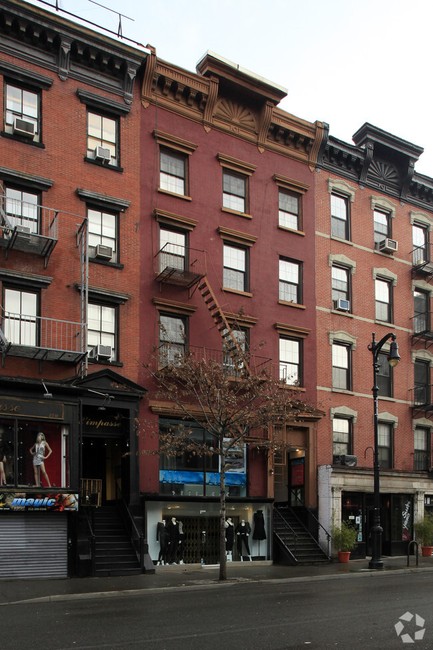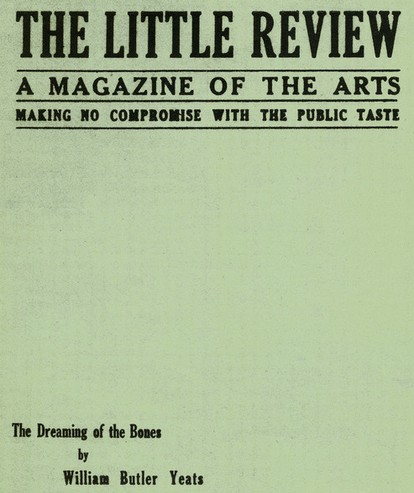Former "Little Review" Office
Introduction
Text-to-speech Audio
Images
The upper floor of the middle building was the residence shared by Anderson and Heap

An issue of the Little Review featuring work by W.B. Yeats

Backstory and Context
Text-to-speech Audio
Margaret Anderson, a native of Indianapolis, moved to Chicago in 1908 and joined the staff of The Dial. She also worked as a book critic for the Chicago Evening Post. She wasn’t entirely satisfied with her jobs, and in 1914, she founded her own journal, which she named The Little Review. Anderson envisioned the journal as something radical, with “the best conversations the world has to offer.”
Strong-willed and charming, Anderson was determined that the journal succeed, and she was able to use her beauty and wit to solicit funding from wealthy patrons. She was equally successful in persuading some of the most acclaimed writers of the day to contribute to The Little Review. In addition to publishing works by political radicals like Emma Goldman, the journal also published Anderson’s defense of homosexuality. In 1916, Anderson met Chicago art teacher, Jane Heap, and the two soon fell in love and moved in together. Heap, often using pseudonyms, worked as co-editor of the Little Review. In 1917, the pair moved to Greenwich Village and began publishing the journal from their upper-floor apartment on 8th Street.Their move to New York was aided by Ezra Pound, who also served as foreign editor of the Little Review in London.
It was Pound who sent Anderson and Heap parts of James Joyce’s Ulysses in 1918, which the pair began serializing in the journal. The pair had published roughly half of the novel in successive issues before they were charged with obscenity. Several issues containing parts of the novel were seized and destroyed by the US Post Office on the grounds that the prose was obscene. When the case went to trial in 1921, Anderson and Heap were found guilty, fined $100, and ordered to discontinue publishing the novel. Later that year, the pair removed the magazine’s motto, “Making No Compromise with the Public Taste,” from the journal’s cover page. The trial drew even more publicity for the journal, with residents of Greenwich Village appearing at the courthouse to protest the proceedings. The experience left Anderson depressed about the state of in the US and she handed over control of the magazine to Heap in 1923. Soon after, Anderson moved to Paris and began a romantic relationship with the French singer Georgette Leblanc.
The Little Review’s last years were marked by a gradual decline, although it had succeeded in publishing some of the best known writers of the day, and many who were then unknown but would go on to become part of the American canon. Among the journal’s many contributors were Djuna Barnes, T.S. Eliot, Gertrude Stein, and W.B. Yeats. The Little Review ceased publication in 1929 and is now regarded as one of the most influential modernist literary journals.
Sources
Jane Heap Dead; Was Editor Here, Long with Little Review--Fined for Printing 'Ulysses', New York Times . June 23rd 1964. Accessed November 12th 2020. https://www.nytimes.com/1964/06/23/archives/jane-heap-dead-was-editor-here-long-with-little-reviewfined-for.html.
"Making No Compromise:" Margaret Anderson and the Little Review , Beinecke Rare Book & Manuscript Library . Accessed November 12th 2020. https://beinecke.library.yale.edu/exhibitions-visiting/special-exhibitions/making-no-compromise-margaret-anderson-and-little-review.
Little Review , Modernist Journals Project . Accessed November 12th 2020. https://modjourn.org/journal/little-review/.
Wisniewski, Mary . The Little Review: Reflecting on the Cultural Influence of a Magazine for Modernists, Made in Chicago in 1914, Chicago Tribune. March 15th 2019. Accessed November 12th 2020. https://www.chicagotribune.com/news/breaking/ct-books-little-review-0324-20190226-story.html.
